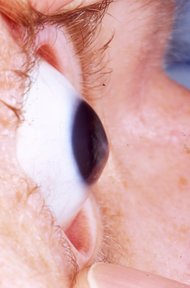Learn about this practitioner's approach to treating keratoconus.
Keratoconus slowly robs young people of their vision and creates a multitude of other problems. Fortunately, a flurry of research is now shedding some light on the mechanisms responsible for this disorder. I also conduct my own research by way of treating several hundred keratoconics each year in my own practice. I have been using a comprehensive nutritional protocol on most of these patients with remarkable results in some - apparently slowing the progression, or in some cases, actually halting keratoconic changes.
The disease
Association of keratoconus with eye rubbing and atopy has been suggested by studies, but its cause has eluded us until now.
* Collagen. Recent studies have suggested that one possible cause of keratoconus involves the increased degradation of the corneal extracellular matrix (collagen) by lysosomal proteolytic enzymes. This enhancement of collagenolytic activity could explain the pathological tissue destruction that's seen in keratoconic corneas.
One of the theories explaining this up-regulation of collagenase activity is based on the observation that fibroblasts derived from keratoconic corneas synthesize a greater amount of the proinflammatory prostaglandin E2 (PGE2) than normal corneas. The E2 class of prostaglandin is a product of the cyclooxygenase pathway and contributes to heightened lysosomal secretion of matrix metalloproteinases (MMPs). These MMPs are responsible, in part, for the accelerated stromal collagen wasting.
* Nutritional treatments. The essential fatty acids eicosapentaenoic acid (EPA) and gammalinoleic acid (GLA) inhibit PGE2 production and act as substrates in the cyclooxygenase pathway for the production of the beneficial anti-inflammatory prostaglandins PGE3 and PGE1. The introduction of these EPAs and GLAs into the diet may significantly alter the keratoconic process by dampening the levels of MMPs and the consequent pathological tissue destruction. Vitamin E has also been shown to suppress PGE2 and is therefore a useful nutrient for patients with keratoconus. Additionally, bioflavonoids have been reported to suppress PGE2 synthesis and confer moderate inhibition of collagenolytic activity of stromal fibroblasts comparable to 40% of the effect of tetracycline.
Decreased collagen synthesis
Due to the combined effects of increased collagenolysis and reduced protease inhibition, there is a gradual reduction of collagen in the keratoconic cornea. The biosynthesis of collagen involves the hydroxylation of proline residues by the enzyme protyl-4hydroxylase of which vitamin C is a co-factor. Increasing the dietary availability of this vitamin may have a favorable effect on disease progression.
Theoretically, bioflavonoids such as quercetin, bilberry, green tea polyphenols and particularly pycnogenol are also useful in keratoconus treatment, as they are all stabilizers of collagen. A recent study reported that flavonoids exert moderate collagenolytic inhibition (through PGE2 and leukotriene inhibition), as well as augment collagen synthesis in fibroblasts. Quercetin is also a natural antihistamine and mast cell stabilizer and may reduce ocular itching and eye rubbing.
Isoflavones
The soy isoflavones genistein and daidzein are phyto-estrogenic compounds with a multitude of pharmacological effects including powerful protease inhibition. They can potentially alter the collagenolytic activity in keratoconus.
Studies with dual focuses
In a study reported in Experimental Eye Research, the alpha 1-proteinase inhibitor found in the epithelium of keratoconic corneas was approximately onefourth of that found in normal human controls. In addition, the stromal extracts of keratoconic corneas contained about onesixth the inhibitor level of that in normal corneas.
A pharmaceutical firm is using a low dose (20mg) tetracycline to combat gingivitis. At that trace amount, tetracycline has very little antimicrobial action, but it's sufficient to exert protease inhibition. Might it also have an application in corneal thinning pathologies?
Pay attention to what's going on in current studies and keep an eye on the effect of your own nutritional protocol. Staying abreast of current information will only increase your credibility with patients as well as your understanding of keratoconus.
JOSEPH M. FREEDMAN, O.D. , Roslyn, N. Y.
Dr. Freedman is a nutritionally oriented optometrist in practice in Roslyn, N.Y. He developed the first antioxidant for ocular use and is a consultant to the nutrition and pharmaceutical industries.
Copyright Boucher Communications, Inc. Mar 2000
Provided by ProQuest Information and Learning Company. All rights Reserved



